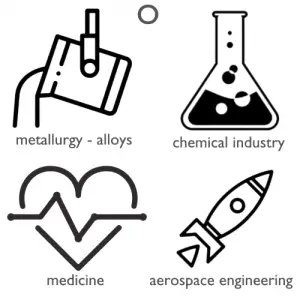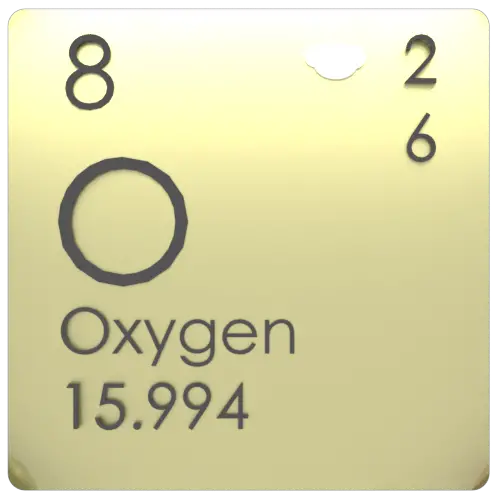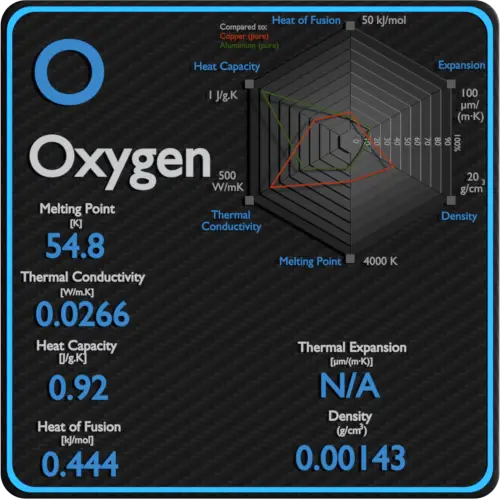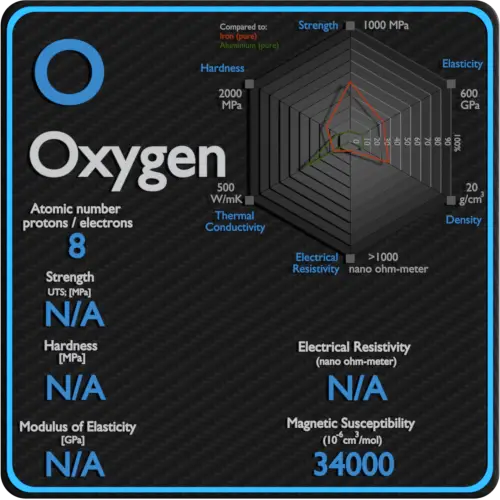About Oxygen
Oxygen is a colourless, odourless reactive gas, the chemical element of atomic number 8 and the life-supporting component of the air. It is a member of the chalcogen group on the periodic table, a highly reactive nonmetal, and an oxidizing agent that readily forms oxides with most elements as well as with other compounds. By mass, oxygen is the third-most abundant element in the universe, after hydrogen and helium.
Summary
| Element | Oxygen |
| Atomic number | 8 |
| Element category | Non Metal |
| Phase at STP | Gas |
| Density | 0.00143 g/cm3 |
| Ultimate Tensile Strength | N/A |
| Yield Strength | N/A |
| Young’s Modulus of Elasticity | N/A |
| Mohs Scale | N/A |
| Brinell Hardness | N/A |
| Vickers Hardness | N/A |
| Melting Point | -218.4 °C |
| Boiling Point | -183 °C |
| Thermal Conductivity | 0.02674 W/mK |
| Thermal Expansion Coefficient | — µm/mK |
| Specific Heat | 0.92 J/g K |
| Heat of Fusion | (O2) 0.444 kJ/mol |
| Heat of Vaporization | (O2) 6.82 kJ/mol |
| Electrical resistivity [nanoOhm meter] | — |
| Magnetic Susceptibility | +3.4e-3 cm^3/mol |
Applications of Oxygen
Common uses of oxygen include production of steel, plastics and textiles, brazing, welding and cutting of steels and other metals, rocket propellant, oxygen therapy, and life support systems in aircraft, submarines, spaceflight and diving. Smelting of iron ore into steel consumes 55% of commercially produced oxygen. In this process, oxygen is injected through a high-pressure lance into molten iron, which removes sulfur impurities and excess carbon as the respective oxides, sulfur dioxide and carbon dioxide. Uptake of oxygen from the air is the essential purpose of respiration, so oxygen supplementation is used in medicine. Treatment not only increases oxygen levels in the patient’s blood, but has the secondary effect of decreasing resistance to blood flow in many types of diseased lungs, easing work load on the heart.
Production and Price of Oxygen
Raw materials prices change daily. They are primarily driven by supply, demand and energy prices. In 2019, prices of pure Oxygen were at around 3 $/kg.
One hundred million tonnes of oxygen are extracted from air for industrial uses annually by two primary methods. The most common method is fractional distillation of liquefied air, with nitrogen distilling as a vapor while oxygen is left as a liquid. The other primary method of producing oxygen is passing a stream of clean, dry air through one bed of a pair of identical zeolite molecular sieves, which absorbs the nitrogen and delivers a gas stream that is 90% to 93% oxygen.
Source: www.luciteria.com
Mechanical Properties of Oxygen
Strength of Oxygen
In mechanics of materials, the strength of a material is its ability to withstand an applied load without failure or plastic deformation. Strength of materials basically considers the relationship between the external loads applied to a material and the resulting deformation or change in material dimensions. In designing structures and machines, it is important to consider these factors, in order that the material selected will have adequate strength to resist applied loads or forces and retain its original shape. Strength of a material is its ability to withstand this applied load without failure or plastic deformation.
For tensile stress, the capacity of a material or structure to withstand loads tending to elongate is known as ultimate tensile strength (UTS). Yield strength or yield stress is the material property defined as the stress at which a material begins to deform plastically whereas yield point is the point where nonlinear (elastic + plastic) deformation begins.
See also: Strength of Materials
Ultimate Tensile Strength of Oxygen
Ultimate tensile strength of Oxygen is N/A.
Yield Strength of Oxygen
Yield strength of Oxygen is N/A.
Modulus of Elasticity of Oxygen
The Young’s modulus of elasticity of Oxygen is N/A.
Hardness of Oxygen
In materials science, hardness is the ability to withstand surface indentation (localized plastic deformation) and scratching. Brinell hardness test is one of indentation hardness tests, that has been developed for hardness testing. In Brinell tests, a hard, spherical indenter is forced under a specific load into the surface of the metal to be tested.
Brinell hardness of Oxygen is approximately N/A.
The Vickers hardness test method was developed by Robert L. Smith and George E. Sandland at Vickers Ltd as an alternative to the Brinell method to measure the hardness of materials. The Vickers hardness test method can be also used as a microhardness test method, which is mostly used for small parts, thin sections, or case depth work.
Vickers hardness of Oxygen is approximately N/A.
Scratch hardness is the measure of how resistant a sample is to permanent plastic deformation due to friction from a sharp object. The most common scale for this qualitative test is Mohs scale, which is used in mineralogy. The Mohs scale of mineral hardness is based on the ability of one natural sample of mineral to scratch another mineral visibly.
Oxygen is has a hardness of approximately N/A.
See also: Hardness of Materials
Oxygen – Crystal Structure
A possible crystal structure of Oxygen is cubic structure.
In metals, and in many other solids, the atoms are arranged in regular arrays called crystals. A crystal lattice is a repeating pattern of mathematical points that extends throughout space. The forces of chemical bonding causes this repetition. It is this repeated pattern which control properties like strength, ductility, density, conductivity (property of conducting or transmitting heat, electricity, etc.), and shape. There are 14 general types of such patterns known as Bravais lattices.
See also: Crystal Structure of Materials
Crystal Structure of Oxygen

Thermal Properties of Oxygen
Oxygen – Melting Point and Boiling Point
Melting point of Oxygen is -218.4°C.
Boiling point of Oxygen is -183°C.
Note that, these points are associated with the standard atmospheric pressure.
Oxygen – Thermal Conductivity
Thermal conductivity of Oxygen is 0.02674 W/(m·K).
The heat transfer characteristics of a solid material are measured by a property called the thermal conductivity, k (or λ), measured in W/m.K. It is a measure of a substance’s ability to transfer heat through a material by conduction. Note that Fourier’s law applies for all matter, regardless of its state (solid, liquid, or gas), therefore, it is also defined for liquids and gases.
Coefficient of Thermal Expansion of Oxygen
Linear thermal expansion coefficient of Oxygen is — µm/(m·K)
Thermal expansion is generally the tendency of matter to change its dimensions in response to a change in temperature. It is usually expressed as a fractional change in length or volume per unit temperature change.
Oxygen – Specific Heat, Latent Heat of Fusion, Latent Heat of Vaporization
Specific heat of Oxygen is 0.92 J/g K.
Heat capacity is an extensive property of matter, meaning it is proportional to the size of the system. Heat capacity C has the unit of energy per degree or energy per kelvin. When expressing the same phenomenon as an intensive property, the heat capacity is divided by the amount of substance, mass, or volume, thus the quantity is independent of the size or extent of the sample.
Latent Heat of Fusion of Oxygen is (O2) 0.444 kJ/mol.
Latent Heat of Vaporization of Oxygen is (O2) 6.82 kJ/mol.
Latent heat is the amount of heat added to or removed from a substance to produce a change in phase. This energy breaks down the intermolecular attractive forces, and also must provide the energy necessary to expand the gas (the pΔV work). When latent heat is added, no temperature change occurs. The enthalpy of vaporization is a function of the pressure at which that transformation takes place.
Oxygen – Electrical Resistivity – Magnetic Susceptibility
Electrical property refers to the response of a material to an applied electric field. One of the principal characteristics of materials is their ability (or lack of ability) to conduct electrical current. Indeed, materials are classified by this property, that is, they are divided into conductors, semiconductors, and nonconductors.
See also: Electrical Properties
Magnetic property refers to the response of a material to an applied magnetic field. The macroscopic magnetic properties of a material are a consequence of interactions between an external magnetic field and the magnetic dipole moments of the constituent atoms. Different materials react to the application of magnetic field differently.
See also: Magnetic Properties
Electrical Resistivity of Oxygen
Electrical resistivity of Oxygen is — nΩ⋅m.
Electrical conductivity and its converse, electrical resistivity, is a fundamental property of a material that quantifies how Oxygen conducts the flow of electric current. Electrical conductivity or specific conductance is the reciprocal of electrical resistivity.
Magnetic Susceptibility of Oxygen
Magnetic susceptibility of Oxygen is +3.4e-3 cm^3/mol.
In electromagnetism, magnetic susceptibility is the measure of the magnetization of a substance. Magnetic susceptibility is a dimensionless proportionality factor that indicates the degree of magnetization of Oxygen in response to an applied magnetic field.


























